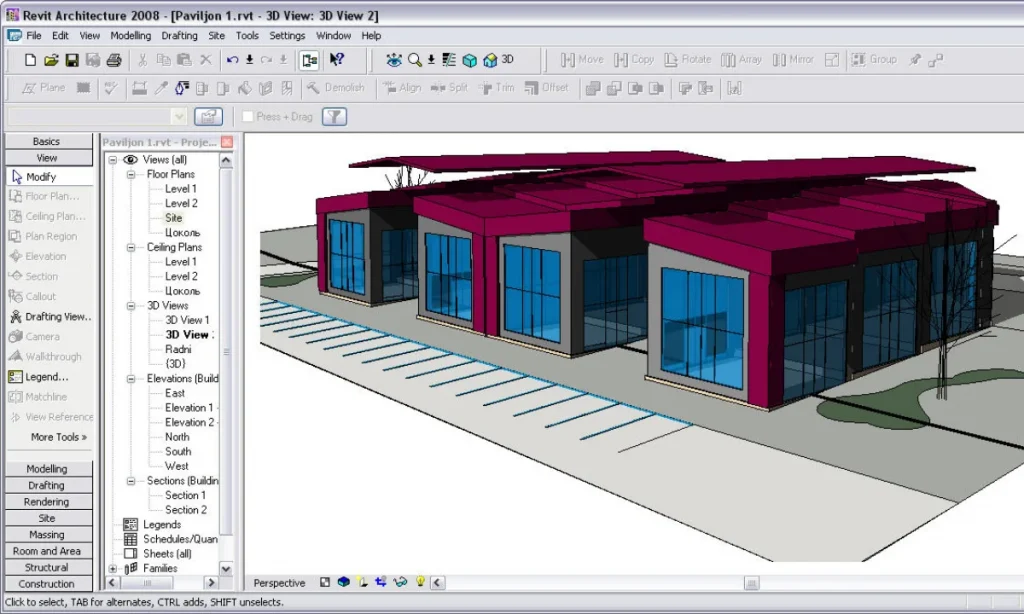
Introduction
Revit Structural Modelling and Detailing is the most comprehensive course available on this subject. You will learn how to:
- Enhance the process of structural modeling and detailing through Revit tools and techniques.
- Seamlessly coordinate with other design disciplines using Revit.
- Fully integrate design and analysis with Revit tools for a more comprehensive approach to building information modeling (BIM).
- Create comprehensive documentation using Revi’s powerful documentation features.
- Model with accuracy, convenience and speed by integrating CAD data into your model quickly, accurately and efficiently using features such as sketching planes or lines directly in 3D views.
Revit Structural Modelling and Detailing
Revit supports a wide range of structural analysis tools, which can be applied to any element in your model. A good understanding of Revit’s basic functionality is essential for anyone who wants to invest in the software or use it as part of their workflow.
You will be able to create complex assemblies through the use of custom components and custom designs, which can also be created within this course!
Enhance the Process
Revit Structural Modelling and Detailing
Revit is a very powerful tool, allowing you to model and detail the structural system. To help you get started with this process, we’ve put together some information about how Revit can help you.
Seamless Coordination
The more you save, the more you’ll earn. The best way to do this is to involve a team of highly skilled people in your project who can assist you with:
- Seamless coordination between the design and construction processes
- Save time and money by eliminating errors
- Models are consistent throughout the project lifecycle, resulting in fewer surprises for everyone involved at each phase of work.
Fully Integrated Design and Analysis
Every aspect of your design and engineering workflow is fully integrated in one application. This means you can create, edit, and annotate your building model in Revit Architecture to meet the needs of each discipline. You can also integrate all aspects of your design and engineering workflow from conception through construction documentation by using BIM workflows that are optimized for efficiency.
- Designers work with engineers to create a coordinated schematic design using linked elements such as architectural walls and structural columns imported from other applications (for example, Autodesk® AutoCAD® software).
- Designers can add information about materials or assemblies directly into their view: select an object such as a wall assembly; right-click it to display its Properties dialog box; modify properties such as material type or thickness; click OK when done.
Comprehensive Documentation
Revit is a powerful documentation tool that allows you to generate large and small documents. Revit’s flexibility makes it possible to create a wide variety of documents quickly, and this versatility makes it an excellent choice for many types of projects.
With Revit you can create beautiful, high-quality technical drawings in a fraction of the time it takes with other CAD systems.
Modeling
Revit is a parametric modeling software that allows users to create a model of the design using building elements. The building elements are created by drawing them in Revit. Once you have drawn your element, you can then specify parameters for that element and give it properties such as length and width.
Once an element has been created, you can then add more information about it by adding annotations such as texts or dimensions directly on the element itself – this is called ‘browsing’. You can also add other types of information by using schedules
(like a floor plan).
Detailing
Detailing is the process of adding detail to a model. It’s a critical stage in the design process and is used to document the design intent of a building, as well as create construction documents.
The goal of detailing is to create drawings that communicate how elements should be fabricated and installed and that describe their location on site. Detailing also includes notes that explain any special conditions or requirements for installation, such as fastening methods or framing details.
In Revit, you can add detail lines to 3D models using the Detail Line tool (I), but this tool doesn’t automatically insert text into your drawing view. You need an additional option like AutoCAD or MicroStation if you want to do detailed layouts with text blocks included in them (AutoCAD Users: AutoDetail).
Revit Structural Detailing
An important part of structural modelling is detailing, which is the process of adding reinforcing bars and other reinforcement items in order to achieve the desired shape. In Revit, there are two ways to add detailed information:
- Detail Lines – This is one of the most common methods used for detailing structural elements in Revit. In this method, you can use any line or arc curve available in your model. You can also apply a thick line style so that it stands out from other geometry lines and can help identify where certain objects are located more easily when looking at renderings or drawings generated from your model. The ability to quickly create an array of similar lines makes this method ideal for creating walls with reinforcement bars along them (see below). However, this method does not allow users much control over how each piece needs to be placed relative to each other; therefore you should consider using another technique instead if your goal is something more nuanced than just connecting several points together with straight lines (for example creating a curved wall).
Structural detailing using Revit
Revit is a very powerful tool for detailing, and you can use it to create, edit and manage structural details. You can also use Revit to create, edit and manage structural annotations. Finally, you can also use Revit for creating, editing and managing structural schedules.
Structural Modelling
You can create a structural model from scratch, or by importing an existing building to use as a base for your model. It’s always best practice to create a new project file when starting a structural modelling project.
To create a structural model from scratch:
- In the Revit Architecture ribbon, click [Structure] in the Model tab and then select New Structural Model. The Create New Structural Model dialog box appears with several options related to how you want to create your structural model (Figure 1). The first option allows you to choose whether or not your new model will be based on another existing one; this feature is useful if you have already drawn out some of the foundation walls and floors in other projects that are similar in size and layout but need adjustments made before continuing with construction drawings.
- Select whether or not this new project should begin with existing geometry; if so, click [Yes]. If not, click [No].
Basic Modeling
To begin, you will want to create a structural model. This is achieved by creating a structural wall family, which can be done by clicking on the Model tab of your ribbon and selecting Create Wall. You should then select Load Into Project from the contextual menu that appears. This will create a structural wall element in your drawing area with no geometry applied to it. If this happens, click on the Edit Group tool in the Home tab of your ribbon, which is located under the Annotate section near the top left corner of your AutoCAD window (if you don’t see an Edit Group button, make sure that you have selected one or more items first).
Once this has been accomplished successfully, double-click on one of its points with either mouse button depressed; if successful then you should see an orange dot appear next to each vertex when doing so (a vertex is where two edges come together). After these dots have appeared use them as guidelines while constraining other lines at their midpoints using constraints such as Parallel and Perpendicular from within Modify | Align toolsets (you can also use Polyline commands here if needed). Now hit ESC twice until all dragging operations cease; once this happens go back into Modify mode again by hitting M again or simply moving over any existing elements
Creating Structural Filters
Now that you have the basics down, let’s get into the more advanced tools in Revit. To get started, you’ll need to create a structural filter. There are several types of filters available:
- Structural Wall Filter
- Structural Column Filter
- Structural Beam Filter
- Structural Foundation Filters (Underwater)
Revit empowers and enables productivity.
Revit enables productivity by:
- supporting collaboration with project teams and clients, enabling them to work together efficiently on the same model.
- enabling structural modelling that goes beyond just structural geometry, but rather adds object properties and understanding of building systems through intelligent tools such as massing, wall framing and wall schedules.
- delivering strong coordination capabilities between designers, engineers and contractors through automated coordination reports.
- allowing for document generation at any stage of a project – from initial design models to construction documents or shop drawings – without having to leave the program environment (no need for time consuming export/import).
Conclusion
Structural detailing using Revit is a powerful tool for engineers, architects and contractors to work together seamlessly. With Revit, you can create models that are more than just 2D drawings or 3D views but have a real-world presence and functionality. Structural modelling enables you to create your own unique architectural designs that can be shared with other members in your team
Follow us to stay updated on LinkedIn, Facebook, Instagram and Twitter.



